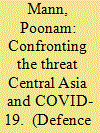| Srl | Item |
| 1 |
ID:
174869


|
|
|
| 2 |
ID:
120314


|
|
|
|
|
| Publication |
2013.
|
| Summary/Abstract |
With continuing challenges facing the international presence in Afghanistan, the need to secure local legitimacy, or 'winning heart and minds' of the local population is gaining increasing foothold in contemporary policy-making and academic debate on international intervention. However, knowledge of how international actors in the field understand local legitimacy remains limited. The purpose of this article is to take a first cut at examining how the two leading actors of international intervention - the UN and NATO - frame the issue of local legitimacy in Afghanistan, and to evaluate the potential impact of these findings on the prospects of inter-organizational coordination in the field. Based on a qualitative comparative analysis of statements issued in UN SC Resolutions, SC Debates, and S-G Reports (2001-2011) and NATO Declarations and Opinions (2003-2011), the study finds that the UN and NATO frame the issue of local legitimacy in surprisingly similar ways. However, the framing appears problematic in terms of how it depicts the relationship between the international presence and the Afghan state and its people. To illustrate, both the UN and NATO tend to externalize the issue of local legitimacy by linking it to the strength of the Afghan state rather than to the quality and effectiveness of international assistance and furthermore do not explicitly recognize Afghan civilians to have any autonomous influence on the level of local legitimacy. Instead, civilians are only portrayed to affect the level of legitimacy indirectly as the victims of insurgent or coalition attacks. The results of the study thus indicate a lack of awareness and self-criticism within the international intervention apparatus towards the potential pitfalls of international assistance, and it signals a lack of attention paid to the agency of local Afghans, which stands the risk of jeopardizing prospects for international civil-military coordination with Afghan stakeholders.
|
|
|
|
|
|
|
|
|
|
|
|
|
|
|
|
| 3 |
ID:
073649


|
|
|
|
|
| Publication |
2006.
|
| Summary/Abstract |
Recognising the failure of both internal and external parties to achieve a peaceful resolution of the Russo - Chechen war, this article seeks to establish what scope remains for international involvement to end the violence in Chechnya. By applying theories from the disciplines of conflict resolution and counterinsurgency to the confrontation, distinctions are drawn between opportunities of peacekeeping, peacemaking and peacebuilding, as well as between legitimate 'need' and exploitative 'greed' at a time of 'violent' politics. Key findings include the scope for international assistance in addressing the root contradictions of the conflict and for curtailing the influence of the 'entrepreneurs of violence'.
|
|
|
|
|
|
|
|
|
|
|
|
|
|
|
|
| 4 |
ID:
142428


|
|
|
|
|
| Summary/Abstract |
In the lead up to the 10th anniversary of the Responsibility to Protect (R2P) agreement, pillar II (which refers to international assistance with state consent) was heralded by the United Nations Special Advisor on R2P as the most promising aspect of the Responsibility to Protect. With so little written on pillar II, however, it is difficult to evaluate this judgement. Addressing this lacuna, this article scrutinizes the promise of pillar II to highlight two key strengths. First, the consensual support for pillar II among UN member states reveals that even those that were critical of the R2P in the aftermath of Libya in 2011 still favour the idea of international assistance. At the same time, there remain concerns over the use of force within pillar II as illustrated by events in Côte d'Ivoire in 2011. Second, the utility of pillar II lies in its potential for addressing the threat posed by non-state armed groups. This is particularly important when one considers that in thirteen of the fourteen years since 2000, rebel groups (rather than governments) have been the primary perpetrators of one-sided mass killing against civilians. Accordingly, pillar II can be seen to hold considerable promise for tackling the threat of mass violence by non-state armed groups in the twenty-first century. However, the article also raises concerns over unintentionally legitimizing illegitimate governments through assistance. To illustrate these points it draws on the assistance provided in Mali (2013–15) and Iraq (2014–15).
|
|
|
|
|
|
|
|
|
|
|
|
|
|
|
|
| 5 |
ID:
097121


|
|
|